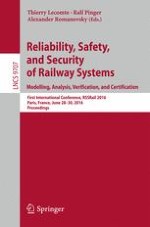2016 | Buch
Reliability, Safety, and Security of Railway Systems. Modelling, Analysis, Verification, and Certification
First International Conference, RSSRail 2016, Paris, France, June 28-30, 2016, Proceedings
herausgegeben von: Thierry Lecomte, Ralf Pinger, Alexander Romanovsky
Verlag: Springer International Publishing
Buchreihe : Lecture Notes in Computer Science
